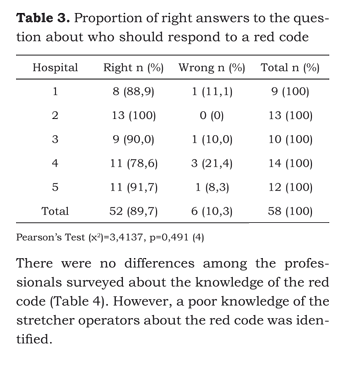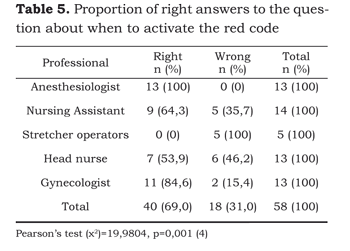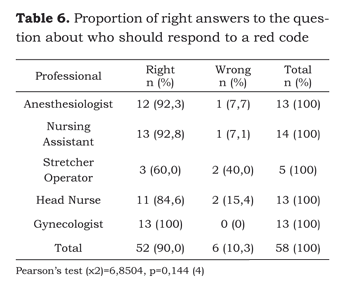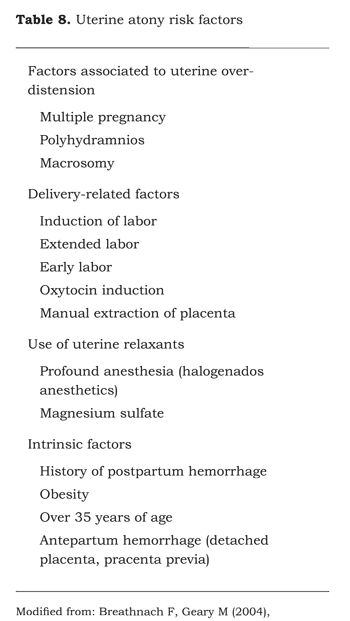Services on Demand
Journal
Article
Indicators
-
 Cited by SciELO
Cited by SciELO -
 Access statistics
Access statistics
Related links
-
 Cited by Google
Cited by Google -
 Similars in
SciELO
Similars in
SciELO -
 Similars in Google
Similars in Google
Share
Colombian Journal of Anestesiology
Print version ISSN 0120-3347
Rev. colomb. anestesiol. vol.38 no.1 Bogotá Jan./Mar. 2010
Red Code Survey in five health care institutions in Bogotá
Andrés García*, J. Ricardo Navarro**, Javier Eslava-Schmalbach**
* Estudiante de primer año de postgrado de Anestesiología, Universidad Nacional de Colombia, Bogotá, D.C., Colombia. E-mail: andresgarciabotero@yahoo.com
** Profesor asociado de Anestesiología, Universidad Nacional de Colombia, Bogotá, D.C., Colombia
ABSTRACT
Introduction: Postpartum Hemorrhage is the first cause of maternal death around the world. The measures adopted in many countries to reduce its morbility have mainly focused on prevention. However, when Postpartum Hemorrhage occurs unexpectedly, following certain strategies such as the red code have proven to be positive. Little is known about how knowledgeable professionals are with the regards to the red code.
Methodology: This study included a survey to determine the level of understanding about the red code by various health-care professionals who take care of obstetric surgical emergencies, at five health-care institutions in Bogotá. The instrument used for evaluation was an eight-questions questionnaire. The first open question assessed the knowledge about the red code; the second question had to do with identification and red code activation; the third had to do with who should be in the team, and then questions four to eight appraised the specific knowledge about Postpartum Hemorrhage.
Results: The results indicate a poor knowledge about the red code by the professionals participating in the survey.
Key words: Postpartum Hemorrhage, Maternal Mortality, Resuscitation (Source: MeSH, NLM)
INTRODUCTION
Obstetric hemorrhage is the single most important cause of maternal mortality worldwide, directly responsible for 30 % of maternal deaths (1). Fourteen million cases of Postpartum Hemorrhage occur every year, with a 1 % mortality, accounting for 140,000 women (one every four minutes) (2). Approximately 88 % of these deaths happen in the first four hours postpartum; hence the need to establish specific prevention measures during labor and in the immediate postpartum. (3).
With the advancements in medical and surgical management of Postpartum Hemorrhage, Maternal Mortality has dropped considerably in the last decade in developed countries such as the United States (1,4). Berg et al showed that 90 % of these deaths are preventable through medical care (5).
The definition of obstetric hemorrhage is not easy because of a lack of agreement regarding how to quantify it and also how much blood loss is considered abnormal. Pritchard in 1962 defined the normal values at 500 ml for vaginal delivery and 1 000 ml for cesarean section (6). The World Health Organization defines it as a blood loss of over 500 ml for vaginal delivery in the first 24 hours; this definition has been established as the critical point beyond which measures should be implemented to prevent any ensuing complications. (7).
It is important to assess the level of knowledge about the red code of the professionals who take care of emergency obstetric patients since obstetric bleeding is one of the main causes for maternal morbimortality around the world. The adoption and implementation of the red code - a rapid Resuscitation system to control obstetric bleeding - has not yet been adequately promoted.
The purpose of the study was to assess the knowledge of emergency health care professionals in the area of obstetric emergencies in level II, III and IV institutions.
MATERIALS AND METHODS
A survey including eight questions was administered to all the heath-care professionals taking care of obstetric patients (anesthesiologists and obstetricians, nursing assistants, graduate nurses and stretcher operators); the first was an open question and the other seven were multiple-choice questions (appendix A). This study was performed in emergency obstetric care level II, III and IV institutions in Bogotá; i.e.: Engativá Hospial, El Tunal Hospital, San Rafael Hospital-Clinic, Kennedy Hospital, and the Maternal Pediatric Hospital in La Victoria.
The instrument used for the evaluation was the eight-question questionnaire. The first questions appraised the knowledge about the red code; the second question had to do with identification and red code activation; the third had to do with who should be in the team, and then questions four to eight appraised the specific knowledge about Postpartum Hemorrhage.
The questionnaire was randomly administered to the team responsible for taking care of this type of emergencies as follows: two obstetricians, two anesthesiologists, two nursing assistants, two head nurses and two stretcher operators.
This hospital staff specializes in pregnant women requiring emergency care at level II, III and IV health care services. The surveys were anonymous and only one letter was used to identify the type of professional answering the questionnaire: A = anesthetist; O = obstetrician; A2 = Nursing Assistant; J = Head nurse; C = stretcher operator. The data were then subject to a statistical analysis.
The sample size was estimated to achieve a proportional difference of 20 % and a probability of 70 % of getting the right answer, for a sample size of 72 subjects, upon 10 % correction for losses.
The participants in the survey verbally expressed their informed consent and the survey received the approval of the heads of anesthesiology at each of the institutions.
A description of the results obtained for each variable is provided in frequency and percentage charts. A hypothesis test was done to assess the percentage differential by institution and by type of professional, using the chi square statistical test.
RESULTS
Only 58/75 (77,3 %) of the subjects completed the survey. 15 health care professionals responsible for the surgical care of the patients were interviewed at each institution, including anesthesiologists, nursing assistants, stretcher operators, head nurses and obstetricians.
With regards to the survey questions, just 20/58 (34,48 %) of the interviewees responded first question correctly.
68,9 % (40/58) responded correctly to the question: "¿When should the red code be activated?" (question 2).
Only 10,34 % (6/58) don´t know who are expected to respond to a red code (question 3).
75,8 % (44/58) know which is the volume of chrystaloids to be administered initially.
34,48 % (20/58) are unaware of the measures to be implement in a red code situation.
56,9 % (33/58) are unaware of the pharmacological measures required by a red
code treatment.
60,34 % (35/58) knows the surgical procedures to be followed.
Only 22 % (13/58) identifies the right procedure for administering blood products.
There were differences in the proportion of right answers by institution to the question: What is the red code?" (Table 1)
No differences were found among the institutions with regards to the knowledge of when to activate the red code. However, the fifth institution shows > 20 % difference in this answer. Tabla 2.
No differences were identified among the various institutions and the knowledge about who should respond to the red code (Table 3).
There were no differences among the professionals surveyed about the knowledge of the red code (Table 4). However, a poor knowledge of the stretcher operators about the red code was identified.
There were significant differences in the level of knowledge of professionals regarding when to activate the red code. (Table 5).
There were differences in the level of knowledge about who should participate in the red code among the group of stretcher operators vs. the other the interviewees. The study was not powerful enough to identify any statistical differences (Table 6).
Knowledge about the therapeutic measures among the various professionals was below 80 % of right answers (x2=1,42, p=0,841).
Although no statistical differences were identified in terms of the appropriate steps in the red code treatment, anesthesiologists showed a lower level of awareness (76,9 %) as compared to other professionals (nursing assistant, 57 %; stretcher operator, 61 %; head nurse, 61 %; and gynecologist, 56 %) (x2=5,87, p=0,2).
There were no differences in terms of the level of awareness of surgical measures, although stretcher operators had a higher proportion of wrong answers (60 %); but this is logical since they are not expected to be knowledgeable on this topic. Gynecologist had a higher percentage of right answers (84,6 %). The percentage of right answers by anesthesiologist, head nurses and nursing assistants was 61,5 %, 61,5 % and 42,8 %, respectively (x2=5,9, p=0,209).
DISCUSSION
Despite the fact that obstetric bleeding is the key scourge leading to the death of pregnant patients, particularly in the first four hours postpartum, this study was unable to identify enough sensitivity among the health care professionals when identifying those actions that if implemented in an orderly fashion may reduce morbimortality for this cause. The question is then whether they are doing things right or whether maternal postpartum mortality due to unexpected bleeding can be reduced (8).
The study was not powerful enough to identify any differences in terms of knowing when to activate the red code, since one of the institutions exhibited >20 % difference.
In order to prevent chaos under critical situations such as Postpartum Hemorrhage, the red code is a fast and specific resource that facilitates the management of any ensuing complications. Approximately 600 to 700 ml of blood flow through the inter-villous spaces of the placenta every minute; this means that failure to take a determined and organized action when obstetric bleeding occurs may rapidly lead to a serious decompensation of the patient and eventually death (7).
This human team must be aware of its specific roles that should be taught, learned and studied through institutional training programs and the use of red code cards (9).
Bleeding of the obstetric patient is usually underestimated (10-12) and this should never be the case, since obstetric bleeding should always be considered a serious event until the hemorrhage is under control, the blood loss has been quantified and hemodynamic stability is achieved (13).
The anesthesiologist plays a crucial role in the care and management of the pregnant patient with unexpected bleeding (table 7).
The red code is a medical system devised by PAHO/WHO, USAID, the Governor´s Office of Antioquia and the Antioquia University (associated to the Latin American Perinatology, Women´s and Reproductive Health Center, CLAP/SMR) (14), so as to provide the health team with a targeted approach following the appropriate steps and working in an orderly and coordinated fashion, that may be replicated whenever needed. The name "red code" represents the life-threatening blood loss and emulates the "Code Blue" for cardiopulmonary Resuscitation.
A review of the document establishing the red code (14) indicates that every time the red code is used, it should be assessed and feedback should be provided to help improve the process and to introduce any institutional adaptations. This survey however reveals that the knowledge about this health policy is poor and hence no feedback is provided for an appropriate assessment of the red code.
It is important to have an informed team of professionals taking care of the pregnant patient. They should be aware about the therapeutic measures to be adopted, such as volume replacement with 3 ml of chrystaloid solution per 1 ml of blood loss; only 20 % of the electrolytic solution volume administered IV for volume replacement is hemodynamically effective after one hour and further deteriorates due to hypothermia and acidosis.
Therefore, if the hypovolemic shock is not resolved within one hour, the possibility for an established disseminated intravascular coagulation should be considered. This information and training should be general knowledge under the red code, in order to prevent and avoid any life-threatening complications from obstetric hemorrhage (14).
Uterine atony is the most frequent cause of Postpartum Hemorrhage and is associated to multiple risk factors (Table 8). Treatment of the condition relies on uterotonic drugs, oxytocin, prostaglandins, and ergot preparations, each one of them with its own specific receptors. Serious side effects have been reported with the use of all three drugs combined, including pulmonary edema (15). Oxytocin is the first line therapy for the treatment of uterine atony.
In patients undergoing elective c-section, the 95 effective dose (ED95) is 0,35 UI as IV bolus, while the dose needed for the pregnant patient in labor who will be referred for c-section is about nine times higher. This difference may be due to fewer oxytocin-binding sites and to myometrial oxytocin receptor desensitization while the patient is in active labor (16-18).
This survey indicated that a little over 20 % of the professional staff that takes care of the obstetric patient complications are not aware of the pharmacological measures or the risks derived from the simultaneous administration of the three uterotonic drugs as required under the code (15).
Among the limitations of this study, the authors acknowledge the lack of power in the comparisons because of the 75 subjects in the sample, only 58 (77,3 %) completed the survey in full. This affects any significant differences that may be identified among the participants and the institutions.
By way of a conclusion and in accordance with the results of the survey, there is a lack of information, education, organization and training of most of the health-care team members, particularly the nursing assistants and the stretcher operators who are key to the successful application of the red code. Similarly, it an be argued that some institutions are ill-informed about this management approach which has been in use throughout the health-care public institutions in the country in the lart two years (14).
La activation of the red code is the responsibility of the first person to come in contact with the postpartum patient that presents with acute bleeding. However, this only happens if there is awareness and prior knowledge. The only way to ensure the successful implementation of the red code is by organizing and training the staff involved with the obstetric patient care. There is still a long way to go before Bogotá implements the red code in 100 % of its II, III and IV level health institutions.
REFERENCES
1. Centers for Disease Control and Prevention. Healthier mothers and babies. MMWR Morb Mortal Wkly Rep. 1999;48:849-58.
2. World Health Organization. Maternal Mortality in 2000. Estimates developed by WHO, UNICEF, and UNFPA. Geneva: Department of Reproductive Health and Research, World Health Organization; 2004.
3. Kane TT, El-Kady AA, Saleh S, Hage M, Stunback J, Potter L. Maternal Mortality in Giza, Egypt: magnitude, causes and prevention. Stud Fam Plann. 1992;23:45-57.
4. Prendiville WJ, Elbourne D, Mc Donald S. Active versus expectant management in the third stage of labour (Cochrane review). In The Cochrane Library, Issue 3, 2003. Oxford Update Software
5. Berg CJ, Harper MA, Atkinson SM, Atkinson SM, Bell EA, Brown HL, et al. Preventability of pregnancy related deaths. Results of a state-wide review. Obstet Gynecol. 2005;106:1228-34.
6. Pritchard JA, Baldwin RM, Dickey JC, Wiggins KR, Reed GP, Bruce DM. Blood volume changes in pregnancy and the puerperium. Am J Obstet Gynecol. 1962;84:1271-82.
7. Tsen LC. Anesthesia for cesarean delivery. In: Chesnut DH, editor. Obstetric Anesthesia principles and practice. Fourth edition. Elsevier; USA; 2009. Ch 26 p. 559.
8. Tsu VD, Langer A, Aldrich T. Postpartum haemorrhage in developing countries: Is the public health community using the right tools? Int J Gynecol Obstet. 2004;85(Suppl.1):s42-51.
9. World Health Organization. Manejo de las complicaciones del embarazo y del parto: guía para médicos y obstetras. WHO/RHR/.7. Washington, D.C.; OPS; 2002.
10. Duthie SJ, Ven D, Yung GL, Guang DZ, Chan SY, Ma HK. Discrepancy between laboratory determination and visual estimation of blood loss during normal delivery. Eur J Obstet Gynecol Reprod Biol. 1991;38:119-24.
11. Larsson C, Saltvedt S, Wiklund I, Pahlen S, Andolf E. Estimation of blood loss after cesarean section and vaginal delivery has low validity with a tendency to exaggeration. Acta Obstet Gynecol Scand. 2006;85:1448-52.
12. Maslovitz S, Barkai G, Lessing JB, Ziv A, Many A. Improved accuracy of postpartum blood loss estimation as assessed by simulation. Acta Obstet Gynecol Scand. 2008;87:929-34.
13. Gallos G, Redai I, Smiley RM . Role of the anesthesiologist in obstetric hemorrhage. Sem Perinatol. 2009;33:116-23.
14. Guía manejo de la hemorragia obstétrica, código rojo,CLAP/SMR- OPS/OMS. Medellín: Gobernación de Antioquia; 2007.
15. Vercauteren M, Palit S, Soetens F, Jacquemyn Y, Alahuhta S. Anaesthesiological considerations on tocolytic and uterotonic therapy in obstetrics. Acta Anaesthesiol Scand. 2009;53:701-9.
16. Balki M, Ronayne M, Davies S, Fallah S, Kingdom J, Windrim R, et al. Minimum oxytocin dose requirement after cesarean delivery for labor arrest. Obstet Gynecol. 2006;107:45-50.
17. de Souza A, Permezel M, Anderson M, Ross A, McMillan J, Walker S. Antenatal erythropoietin and intra-operative cell salvage in a Jehovah´s witness with placenta praevia. Br J Obstet Gynaecol. 2003;110:524- 6.
18. Carvalho JC, Balki M, Kingdom J, Windrim R. Oxytocin requirements at elective cesarean delivery: A dose-finding study. Obstet Gynecol. 2004;104:1005-10.
Red Code Questionnaire
Mark your answer with an X.
1. What is the red code?
2. When should the red code be activated?
a. Postpartum bleeding >250 ml and 5 % reduction in hematocrite
b. Bleeding following c-section >800 ml
c. Bleeding following c-section >1 000 ml
d. Postpartum bleeding >400 ml not requiring red cells transfusion
3. Who should respond to a red code?
a. Gynecologist and hospital physician
b. Treating physician and nursing assistant in charge
c. Gynecologist, anesthesiologist, nurse
d. Stretcher operator, hospital physician, pediatrician
4. What volume of chrystaloid fluids should be administered initially?
a. 5 % Dextrose in 500 ml distilled water
b. 0,9 % Saline solution in 1 000 ml
c. Ringer lactate or 0,9 % saline solution in 2 000 ml
d. Ringer lactate or 0,9 % saline solution in 1 500 ml
5. Which of the following measures should be implemented in response to a red code?
a. Bladder emptying though a catheter
b. Uterine revision under general anesthesia
c. Bi-manual uterine massage
d. All of the above
6. Which of the following drug therapies are indicated when treating a red code?
a. 40 U of oxytocin in 500 ml of lactate at 125 ml per hour; misoprostol 4 to 6 intrarectal tablets and 0,2 mg of IM methylergonovine
b. 40 U of oxytocin in 500 ml of lactate at 125 ml per hour; misoprostol 4 to 6 intrarectal tablet and 0,1 mg of IM methylergonovine
c. 40 U of oxytocine in 500 ml of lactate at 125 ml per hour; misoprostol 2 intrarectal tablets and 0,1 mg of IM methyilergonovine
d. 40 U of oxytocine in 500 ml of lactate at 125 ml per hour; misoprostol 2 intrarectal tablets and 0,2 mg of IM methylergonovine
7. If the uterine bleeding persists, the patient must be taken to the OR for surgical control of hemorrhage. The following are the options to consider,with the exception of:
a. Tubal ligation
b. Total or sub-total hysterectomy
c. Progressive uterine devascularization
d. Pelvic tamponade under traction
8. In case of serious chock, which of the following actions should not be taken?
a. Administer one unit of red cells in 15 minutes
b. Administer O RH negative whole blood
c. Administer O Rh positive blood until cross testing is done (in the absence of O Rh negative).
d. Administer 1 unit of platelets per 10 kg of body weight
1. Centers for Disease Control and Prevention. Healthier mothers and babies. MMWR Morb Mortal Wkly Rep. 1999;48:849-58. [ Links ]
2. World Health Organization. Maternal mortality in 2000. Estimates developed by WHO, UNICEF, and UNFPA. Geneva: Department of Reproductive Health and Research, World Health Organization; 2004. [ Links ]
3. Kane TT, El-Kady AA, Saleh S, Hage M, Stunback J, Potter L. Maternal mortality in Giza, Egypt: magnitude, causes and prevention. Stud Fam Plann. 1992;23:45-57. [ Links ]
4. Prendiville WJ, Elbourne D, Mc Donald S. Active versus expectant management in the third stage of labour (Cochrane review). In The Cochrane Library, Issue 3, 2003. Oxford Update Software [ Links ]
5. Berg CJ, Harper MA, Atkinson SM, Atkinson SM, Bell EA, Brown HL, et al. Preventability of pregnancy related deaths. Results of a state-wide review. Obstet Gynecol. 2005;106:1228-34. [ Links ]
6. Pritchard JA, Baldwin RM, Dickey JC, Wiggins KR, Reed GP, Bruce DM. Blood volume changes in pregnancy and the puerperium. Am J Obstet Gynecol. 1962;84:1271-82. [ Links ]
7. Tsen LC. Anesthesia for cesarean delivery. In: Chesnut DH, editor. Obstetric Anesthesia principles and practice. Fourth edition. Elsevier; USA; 2009. Ch 26 p. 559. [ Links ]
8. Tsu VD, Langer A, Aldrich T. Postpartum haemorrhage in developing countries: Is the public health community using the right tools? Int J Gynecol Obstet. 2004;85(Suppl.1):s42-51. [ Links ]
9. World Health Organization. Manejo de las complicaciones del embarazo y del parto: guía para médicos y obstetras. WHO/RHR/.7. Washington, D.C.; OPS; 2002. [ Links ]
10. Duthie SJ, Ven D, Yung GL, Guang DZ, Chan SY, Ma HK. Discrepancy between laboratory determination and visual estimation of blood loss during normal delivery. Eur J Obstet Gynecol Reprod Biol. 1991;38:119-24. [ Links ]
11. Larsson C, Saltvedt S, Wiklund I, Pahlen S, Andolf E. Estimation of blood loss after cesarean section and vaginal delivery has low validity with a tendency to exaggeration. Acta Obstet Gynecol Scand. 2006;85:1448-52. [ Links ]
12. Maslovitz S, Barkai G, Lessing JB, Ziv A, Many A. Improved accuracy of postpartum blood loss estimation as assessed by simulation. Acta Obstet Gynecol Scand. 2008;87:929-34. [ Links ]
13. Gallos G, Redai I, Smiley RM . Role of the anesthesiologist in obstetric hemorrhage. Sem Perinatol. 2009;33:116-23. [ Links ]
14. Guía manejo de la hemorragia obstétrica, código rojo,CLAP/SMR- OPS/OMS. Medellín: Gobernación de Antioquia; 2007. [ Links ]
15. Vercauteren M, Palit S, Soetens F, Jacquemyn Y, Alahuhta S. Anaesthesiological considerations on tocolytic and uterotonic therapy in obstetrics. Acta Anaesthesiol Scand. 2009;53:701-9. [ Links ]
16. Balki M, Ronayne M, Davies S, Fallah S, Kingdom J, Windrim R, et al. Minimum oxytocin dose requirement after cesarean delivery for labor arrest. Obstet Gynecol. 2006;107:45-50. [ Links ]
17. de Souza A, Permezel M, Anderson M, Ross A, McMillan J, Walker S. Antenatal erythropoietin and intra-operative cell salvage in a Jehovah´s witness with placenta praevia. Br J Obstet Gynaecol. 2003;110:524- 6. [ Links ]
18. Carvalho JC, Balki M, Kingdom J, Windrim R. Oxytocin requirements at elective cesarean delivery: A dose-finding study. Obstet Gynecol. 2004;104:1005-10. [ Links ]











 text in
text in 







